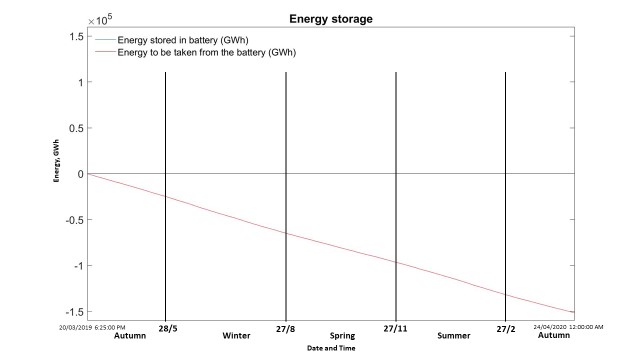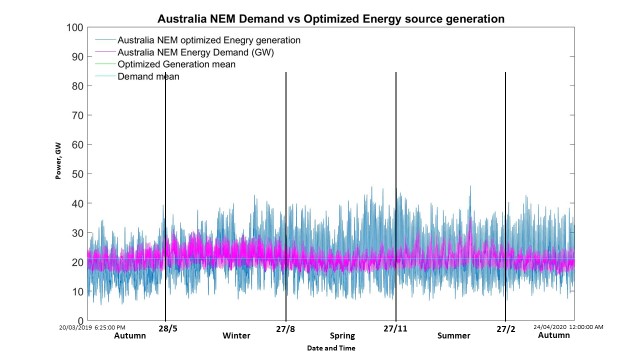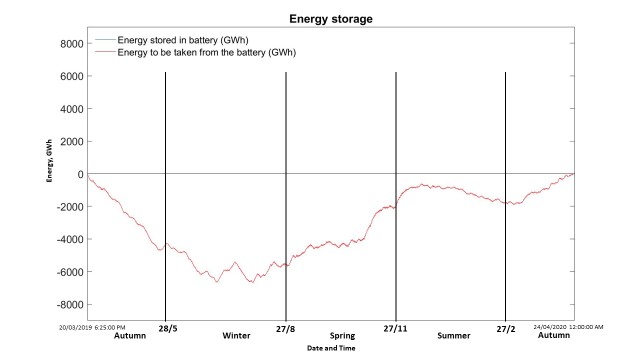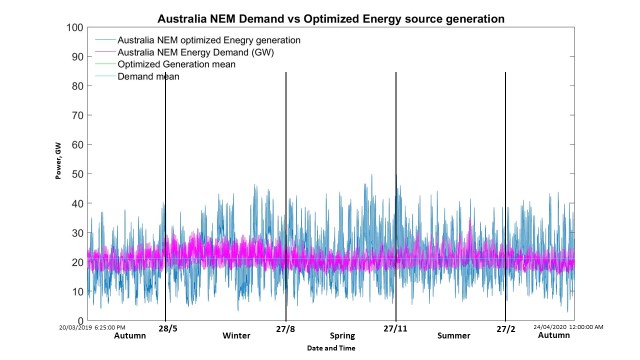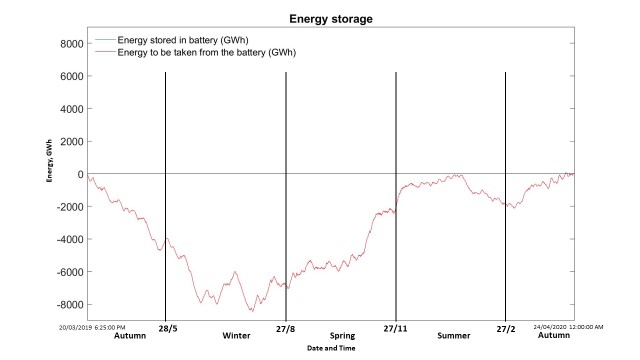Projects:2020s1-2432 How much Energy Storage does Australia need?
Contents
Introduction
The aim of this project is to gain perspective on how much energy storage is needed to ensure demand supply balance due to the intermittency of renewable energy sources. A significant amount of renewable energy generation has been added since 2018. In 2019, 24% of Australia’s electricity generation is from renewable energy[1]. The increasing reliance on renewable energy led us to question how much energy storage does Australia need? Because energy storage is such an important aspect of renewable energy growth. Australian Energy Market Operator (AEMO) projects that by 2036 Australia's battery energy storage capacity will be 6.6 GWh[2].
Project Team
Project Students
- Nasser Khanezan
- Jun Wei Kuan
Project Supervisors
- Derek Abbott
- David Vowles
Background
Research
Result & Discussion
As the result, we have completed the analysis for three different cases. The first case is the baseline case, with the condition of existing renewable energy source. The second case is the case, where we multiplied the wind energy and solar energy generation with its optimized coefficient while keeping the rooftop PV and hydro energy generation fixed. Whereas, in the last case, we scaled up all the renewable energy source with a scaling factor, that we have calculated by taking the ratio of total energy demand to total renewable energy generation in a year. The most important constraint to develop a Energy storage for Australia renewable energy supply is that, the total renewable energy source must be greater or equal to the total energy demand for the whole year. In order to compare and visualize the battery storage, in term of its physical size and energy storage capacity, it is compared by Hornsdale battery[3], Snowy 2.0 pumped hydro storage, and the Gordon Dam in Tasmania. The Hornsdale battery is the second largest lithium-ion battery in the world, located in South Australia, and co-located with Hornsdale Wind Farm[3]. In November 2019, Neoen confirmed that its storage capacity will be increased up to 0.1935 GWh. Snowy 2.0 pumped hydro storage is the largest renewable energy project in Australia[4], as well as largest energy storage project in the southern hemisphere, with the storage capacity of 350 GWh[5]. The Gordon Dam in Tasmania is the
a) Baseline case
A graph of the existing renewable power generation(GW) versus power demand(GW) is plotted with no modification on the renewable energy source. As shown in the figure xx, the power demand is significantly higher than the renewable power generation throughout the year. In order to meet the power demand required, excess power supply is required to be retrieved from the batter power storage. Therefore, a constant extra power supply is needed throughout the year, and eventually a Energy storage graph with a constant negative slope is obtained, which indicated infinite battery storage. For the period from 20/03/2019 to 24/04/2020, the energy storage required to meet the power deficit of this period of time is found to be 151700 GWh, which is equivalent to 783979 Hornsdale battery
b)Renewable energy generation with: 7*wind + 7.7*solar + 1*rooftop PV + 1*hydro
By multiplying wind energy source by 7 and solar energy source by 7.7 while keeping rooftop PV and hydro energy source constant, the total renewable energy generated throughout the year will be sufficient to meet the total energy demand for the whole year. During winter, the power deficit will come to its peak, which indicates that the battery storage capacity should be designed such that it is sufficient to store enough energy to supply the power shortage during these period of times. The graph of additional energy supply needed from the battery to overcome the power deficit is plotted. The highest negative value in the graph indicated the minimum amount of battery energy storage required to cope with the worst time of power shortage in the whole year.
c) All the renewable energy sources are multiplied by a scaling factor of 4.1308
In this case, all the renewable energy sources are multiplied by 4.1308, in order to ensure that the total renewable energy generation is equal to the total energy demand throughout the year. Since all the renewable energy sources are multiplied by 4.1308, the power generation is evenly distributed throughout the year with little fluctuation. The power demand reaches its peak on winter period, which possibly due to high domestic heater usage. As the result, the battery storage required will be needed to overcome the power deficit during winter time. The highest negative value of the energy storage graph is found in winter period, which indicates the minimum battery energy capacity required to overcome to worst time of power shortage in the whole year.
Conclusion
Future Work
References
[3] Hornsdale Power Reserve. 2020. Hornsdale Power Reserve | South Australia's Big Battery. [online] Available at: <https://hornsdalepowerreserve.com.au/> [Accessed 17 October 2020]. [4] Snowy Hydro. 2020. About - Snowy Hydro. [online] Available at: <https://www.snowyhydro.com.au/snowy-20/about/> [Accessed 17 October 2020].
[5] “Pumped hydro | energy.gov.au.” https://www.energy.gov.au/government-priorities/energy-supply/pumped-hydro-and-snowy-20 (accessed: Oct. 18, 2020).

